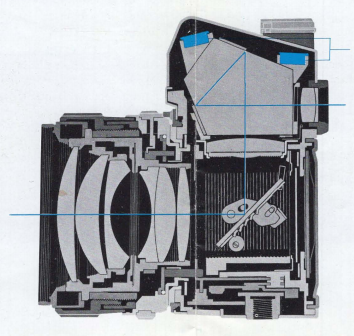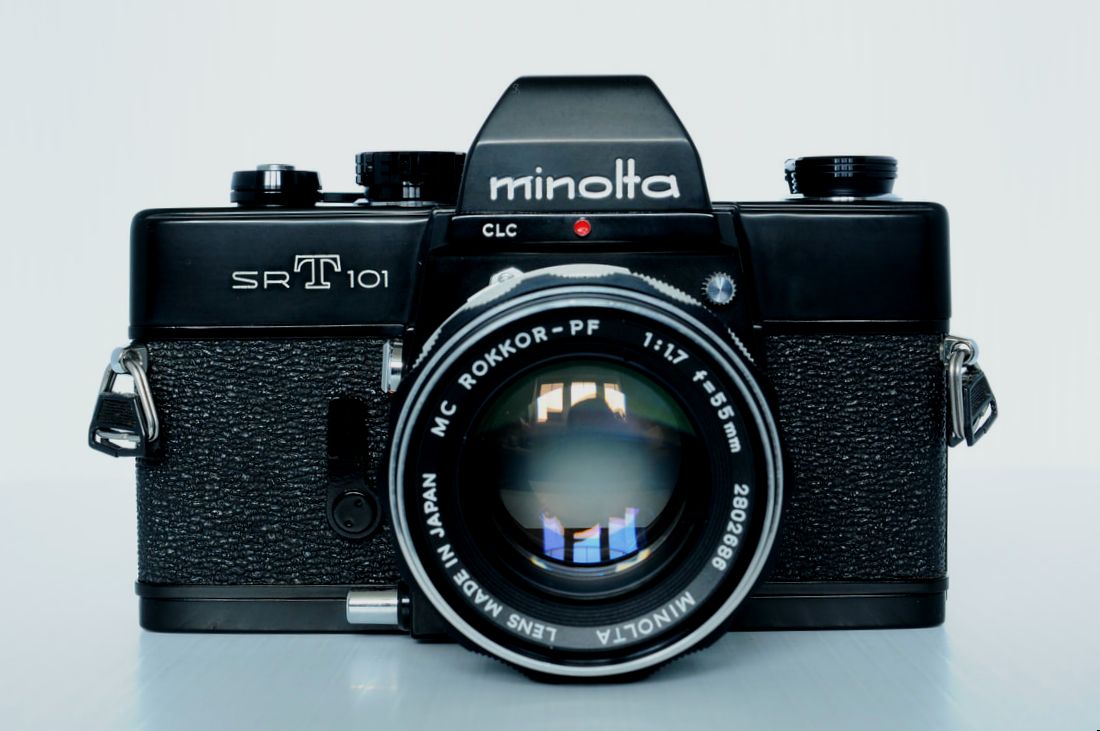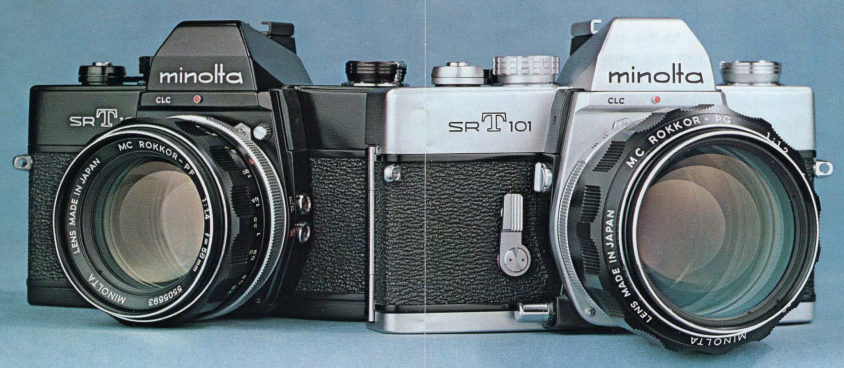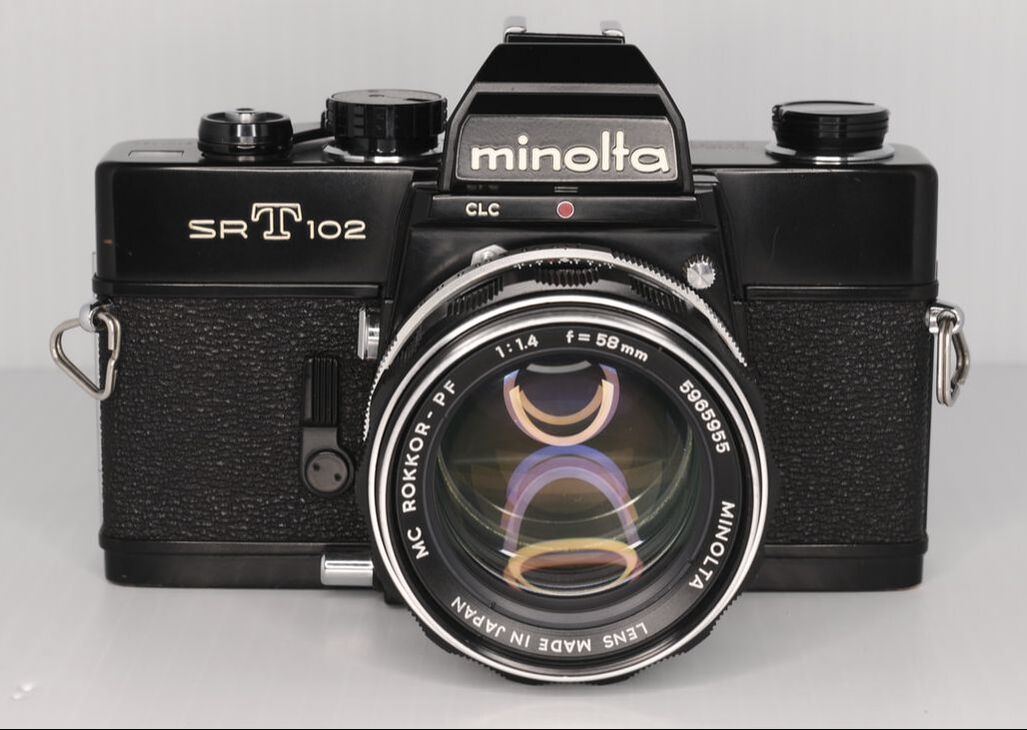|
Updated Oct. 19, 2021 The mid-1960s were heady days in SLRland. From 1964-66 all of the Big 4 Japanese manufacturers brought out new top-of-the-line enthusiast models: the Pentax Spotmatic (1964); the Nikkormat FT (1965); Canon's Pellix (1965) and FTQL (1966); and the object of our attention in this article...Minolta's SRT (1966). The feature all of these cameras had in common was: built-in through-the-lens (TTL) metering. We take it for granted now, but five decades ago this was revolutionary. Of the five models, the Pentax and Canons used stop-down metering (meaning that the photographer had to manually close (stop-down) the aperture on the lens to get an accurate reading and then focus at maximum aperture). The Nikkormat offered full-aperture metering (the lens remained at maximum aperture for the brightest view and ease of focusing while the meter reading was taken), but required the user to manually index the aperture ring every time that they changed lenses. Then came the SRT-101. Full-aperture metering and the aperture automatically indexed whenever you mounted a lens. No muss, no fuss. And all it took was: a little spring... a little string... and a little tab on the aperture ring ;-) From SR to SRT Before we take a closer look at the SRT, let's get a bit of context. Minolta introduced its state-of-the-art SR (likely for Single-Lens Reflex) lens mount in 1958. This mount was the fastest-acting 35mm lens mount system available at the time. It only required the user to match up index marks on the lens and camera, insert the lens, and give it a 54-degree twist to lock it in place. Beginning with the SR-2 in 1958 and embarking on a constant improvement program with the follow-on SR-3 and SR-7 models through 1965, Minolta laid the foundation for the SRT-101 that debuted in April 1966. Here is a brief summary of that evolutionary process:
With the SRT-101, Minolta chose to bypass the intermediate step of stop-down TTL metering. It was not that they didn't consider such a move (they had developed a prototype SR 777 that used such a system), but they astutely chose to push ahead of Pentax instead of just being content to catch up to them. Nikon faced a similar choice with their Nikkormat line and put an extra five months of development into the FT rather than stick with their original stop-down design. Although the fruitage of such decisions was some time in coming (Pentax absolutely dominated SLR sales through the late-'60s with their Spotmatics), full-aperture TTL-metering was here to stay. By late-1970, Canon had seen the writing on the wall and introduced its FD-mount (basically the FL-mount modified for full-aperture metering and automatic exposure). Pentax hung onto stop-down metering until 1973 and this decision (along with failing to replace the M42 screwmount prior to 1975) dropped them from the top of the sales charts for good; a strategic misstep from which they never quite recovered. But it was not just the metering method that made the SRT a success. A Closer Look Obviously, the SRT was not the first SLR to offer full-aperture TTL metering. That honor went to the Topcon RE Super (Super D in the USA, which even pre-dated the Pentax Spotmatic, being developed in 1962 and introduced in 1963). But being first does not necessarily mean being the best or most successful. The otherwise-superb Topcon's problem was its antiquated Exakta-style lens mount and Nikon F-topping price. Outside of the US Navy, customers were few and far between. So while not necessarily superior in capability, the SRT was far more affordable, had a modern lens mount with plenty of room to grow, and the simplest full-aperture metering mechanism available. It basically consisted of a spring-loaded collar that rotated behind the lens-mount flange coupled to the exposure meter by (wait for it...) a spring...a string...and a couple of pulleys. A post on the collar engaged a tab on the aperture ring of the simultaneously-introduced MC (Meter-Coupled) Rokkor lenses and voila!...full-aperture TTL and no messing around with goofy rabbit ears and making sure that the aperture ring was set to f/5.6...yadda, yadda, yadda. Speaking of Nikon :-), over ten years later they would copy this system when they introduced their AI (Automatic Aperture-Indexing) lenses in 1977. That's as much of a ringing endorsement of someone else's innovation as you would ever get out of the Nikon boys and their usual NIH (not-invented-here) mindset. I'm pretty sure they and Minolta worked a little something out behind closed doors...you know what I'm saying...badda-bing...badda-boom? Annnywaaays...this was a classic example of Minolta engineering at its best - simple & effective.  Cutaway of CLC meter Cutaway of CLC meter It wasn't just on the meter-coupling front that the SRT broke new ground, it was also with the metering pattern itself. The averaging meters then common were easily fooled by a bright sky with a darker foreground, or vice-versa. Minolta's solution was CLC (Contrast Light Compensator) metering. It used two CdS cells mounted to the pentaprism, one of which read the overall scene in the viewfinder, while the second was biased toward the top of the viewfinder (where the sky would generally be in a horizontal composition). The cells were wired in series, so a combined reading was obtained and the meter would adjust for strong backlighting. While admittedly not infallible, CLC was just as good as and often better than other in-camera meters then on the market and could be considered the second rudimentary multizone meter (behind Topcon's more-sophisticated RE Super). Minolta used CLC metering in its top cameras, both SLRs and rangefinders, until the late-'70s, and they stayed near the forefront of meter development for the next 30 years or more. Nor was it just in technical capability that the SRT moved the needle, it was also in the way it felt and functioned. Eight years of improvements in manufacturing expertise and design by Minolta's engineers were immediately evident. The controls moved with precision and purpose. Build quality and reliability were improved over its ancestors and would continue to advance during the first decade of its existence. One handy thing that did carry over to the SRT from the SR 777 prototype was a lockable depth-of-field (DOF) preview lever, which allowed stop-down metering with the older (non-MC) Auto Rokkors, thus maintaining backward compatibility with the entire Minolta lens lineup. The SRT-101 was also among the first SLRs to display the set shutter speed (thanks to another string and pulley system :-)) in the viewfinder. Such features made it state-of-the-art at the time. Minolta would iterate the SRT up and down its model lineup over its 15-year lifespan, with remarkably few changes to the basic chassis and layout. Here is an overview:
Life With an SRT So, why consider an SRT? It often comes down to the letter "M". If you need/want a Minolta with...
SRTs are solid, reliable, easily serviced, and plentiful (over 3.5 million bodies were sold in 15 years). There were literally millions of SR-mount lenses produced too, and most of them are available at bargain prices, nowadays. SRTs did use the now-obsolete 1.35V 625 mercury cell to power the meter, but conversion for a modern 357 silver-oxide battery (with an o-ring to center it in the battery chamber) takes about 20 minutes with modest soldering skills, or you can use a 675 hearing-aid battery (super-cheap to purchase in bulk) with an o-ring, which will last for a few months at a time. Or you can always opt for a handheld meter or Sunny 16. One functional faux pas is the ON/OFF/Battery Check switch. A hold-over from the SR-7, it is located on the bottom plate of the camera and it is very easy to leave in the ON position accidentally. You have to train yourself to check it EVERY time you are putting the camera away. A common occurrence is that the plastic tip on the film advance lever will be missing or partially broken off due to someone's overzealous winding technique. This is a minor issue, but there are enough SRTs out there that you can easily find one with an intact tip. Like most of its contemporaries, the SRT has a longish film stroke of 170 degrees (20 degree standout + 150 degrees actual winding). Fortunately, it uses a ratcheting mechanism, so you can use multiple short strokes if you prefer. The advantage of the long winding throw is a fair amount of mechanical advantage, so winding is smooth and light. For the absolute full-meal-deal, look for an early -102, -303, or Super. They have the full viewfinder display, hot shoe, MLU and multiple exposure capability. If you don't need MLU, the -202, -303b, or SR-505 (the SR-505 is quite rare) are the next best thing and they get you the film-safe-load window. If you choose an SRT-101, I highly recommend getting a post-1969 body (easily identified by the coarse checker-style knurling on the shutter speed dial and the cross-point (+) body and mount screws). That makes turning the shutter speed dial a one-finger affair along with getting you all of the internal improvements made during the preceding four years of production. On the other hand, if you are looking for the minimalist SRT experience, an SRT-200 will fill the bill nicely. Think of it as a Pentax K1000-equivalent, minus the silver oxide 357 battery. It is a perfect candidate for the 675 hearing-aid battery treatment. And they can be had for dirt-cheap with a 50/2 lens. In other words, there is an SRT for just about anyone. They also make great cold-weather cameras and long-exposures are a breeze, too. I have used my -102 @ -20 Celsius with no problems whatsoever. SRTs also pair beautifully with any Minolta MF lens, although there is something special when you plunk an all-metal MC Rokkor on one loaded with B&W :-). Totally symphonic, brah. Later days. References: The Rokkor Files @ http://www.rokkorfiles.com/ Minolta, Pentax, Nikon, Canon, & Topcon Manuals @ www.butkus.org Part 5: Nikomat FT/FS @ http://imaging.nikon.com/history/chronicle/ Part 6: Nikomat FTN @ http://imaging.nikon.com/history/chronicle/ Canon Pellix QL & FT QL @ https://global.canon/en/c-museum/ Asahi Pentax Spotmatic @ http://www.pentax-slr.com/71760549 Topcon RE Super @ https://www.shutterbug.com/content/
2 Comments
Mel Jones
11/26/2019 07:21:58 am
Thanks to this article I bought an SRT101 with a mint Rokkor f1.4 lens that someone had never used. My oh my what a beautiful responsive camera it is. I have just had the first test roll back and the Rokkor glass gives a rendition that would run my Nikkors a very close finish. The camera has called the expousre right on every shot and with its very uncluttered viewfinder is a real pleasure to shoot with. So thanks CJ for bringing this gem to my attention.
Reply
C.J. Odenbach
11/26/2019 12:28:10 pm
Hi Mel,
Reply
Your comment will be posted after it is approved.
Leave a Reply. |
C.J. OdenbachSuffers from a quarter-century and counting film and manual focus SLR addiction. Has recently expanded into 1980's AF point and shoots, and (gack!) '90s SLRs. He even mixes in some digital. Definitely a sick man. Categories
All
Archives
June 2024
|



 RSS Feed
RSS Feed